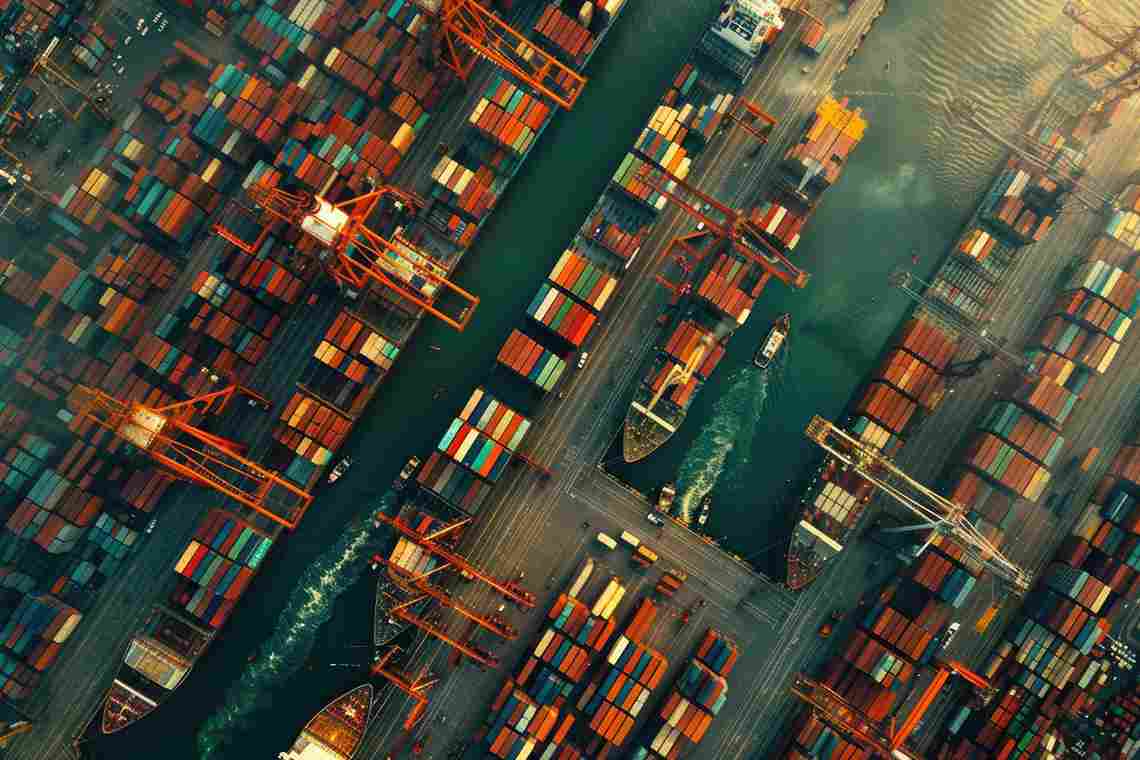When you think of forex trading, you probably imagine charts, exchange rates, and market predictions. But have you ever considered how US import prices play a role in this complex dance? Let’s dive deep into the intricate relationship between US import prices and forex trading. Buckle up, because this journey is going to be both informative and a bit of a rollercoaster ride.

Understanding the nuances of forex trading requires a grasp of various economic indicators, one of which is US import prices. These prices can significantly impact currency values and trading decisions. Let’s explore how this happens and why it matters to forex traders.
What Are US Import Prices?
US import prices reflect the cost of goods purchased from other countries. These prices are influenced by various factors, including global supply chains, tariffs, and international trade agreements. They are a crucial indicator of economic health, providing insights into inflation and purchasing power.
Factors Affecting US Import Prices
Numerous elements can sway import prices. Tariffs and trade policies are major players, but so are changes in the global economy. For instance, a natural disaster in a key exporting country can drive up prices. Similarly, shifts in currency values can make imports more or less expensive.
How Are Import Prices Measured?
The Bureau of Labor Statistics (BLS) measures import prices through detailed surveys and data collection. This information is released monthly, providing a regular update on the state of international trade and its impact on the US economy.
The Connection Between Import Prices and Forex Trading
Forex trading revolves around currency values, and import prices can significantly influence these values. When import prices rise, it often signals inflation, which can affect the value of the US dollar. Traders need to keep an eye on these prices to make informed decisions.
Inflation and Currency Value

Higher import prices can lead to inflation, as businesses pass on the increased costs to consumers. Inflation typically devalues a currency, as it erodes purchasing power. For forex traders, understanding this relationship is crucial for predicting currency movements.
Trade Balance and Currency Strength
Import prices also impact the trade balance, which is the difference between a country’s imports and exports. A negative trade balance, or trade deficit, can weaken a currency, as more money flows out of the country. Conversely, a positive trade balance can strengthen the currency.
Why Forex Traders Should Monitor US Import Prices
Monitoring US import prices gives forex traders an edge. By understanding the trends and factors affecting these prices, traders can better predict currency movements and market reactions.
Predicting Market Movements
Forex markets react to economic indicators, and import prices are no exception. When import prices rise unexpectedly, it can lead to market volatility. Traders who anticipate these movements can position themselves to profit from the resulting currency fluctuations.
Making Informed Trading Decisions
Informed traders are successful traders. By keeping an eye on import prices, traders can make decisions based on solid data rather than speculation. This reduces risk and increases the likelihood of successful trades.
Recent Trends in US Import Prices

To understand the current landscape, let’s look at some recent trends in US import prices. Over the past few years, various factors have influenced these prices, including global supply chain disruptions and changes in trade policies.
Impact of COVID-19 on Import Prices
The COVID-19 pandemic caused significant disruptions in global supply chains. This led to increased import prices as supply struggled to meet demand. Forex traders had to adapt quickly to these changes, adjusting their strategies to account for increased volatility.
Effects of Trade Wars and Tariffs
Trade wars, particularly between the US and China, have also impacted import prices. Tariffs on goods from China led to higher prices, affecting inflation and the value of the US dollar. Forex traders who monitored these developments were better positioned to navigate the market.
Analyzing Import Price Data for Forex Trading
Interpreting import price data requires a keen eye and an understanding of the broader economic context. Traders need to analyze this data in conjunction with other indicators to get a complete picture of the market.
Using Economic Indicators
Import prices should be considered alongside other economic indicators like GDP, unemployment rates, and consumer confidence. This holistic approach allows traders to make more accurate predictions about currency movements.
Technical Analysis
In addition to fundamental analysis, technical analysis can help traders understand how import prices influence currency values. By examining historical data and price charts, traders can identify patterns and trends that inform their trading strategies.
The Role of Government Policies
Government policies play a crucial role in shaping import prices. From tariffs to trade agreements, these policies can have significant impacts on the cost of imports and, consequently, on forex trading.

Trade Agreements and Their Impact
Trade agreements can lower import prices by reducing tariffs and other barriers. For example, the US-Mexico-Canada Agreement (USMCA) aimed to create more favorable trading conditions, impacting import prices and currency values.
Tariffs and Trade Barriers
Conversely, tariffs and trade barriers can increase import prices. The US-China trade war is a prime example, where tariffs led to higher costs for imported goods. Forex traders need to stay informed about these policies to anticipate market changes.
Strategies for Forex Traders
With a solid understanding of how import prices affect forex trading, let’s explore some strategies traders can use to incorporate this knowledge into their trading plans.
Hedging Against Inflation
One strategy is to hedge against inflation by investing in assets that tend to appreciate when inflation rises. Gold is a popular choice, as it often retains its value during inflationary periods. This can protect traders from the negative impact of rising import prices.
Diversifying Currency Pairs
Diversification is key in forex trading. By trading multiple currency pairs, traders can spread their risk. This is particularly important when import prices are volatile, as it reduces the impact of any single market movement on their portfolio.
Case Studies: Forex Trading and Import Prices
Real-world examples can illustrate the practical impact of import prices on forex trading. Let’s look at a couple of case studies to see how traders have navigated this complex relationship.
Case Study 1: The Impact of Rising Oil Prices
Oil is a major import for the US, and changes in oil prices can significantly impact import costs. During periods of rising oil prices, forex traders often see a weakening of the US dollar. By anticipating these changes, savvy traders can adjust their strategies accordingly.
Case Study 2: The US-China Trade War
The US-China trade war offers another example. When tariffs were imposed on Chinese goods, import prices rose, leading to inflationary pressures. Traders who monitored these developments were able to capitalize on the resulting currency fluctuations.
Challenges in Predicting Import Prices

Predicting import prices is not without its challenges. Various factors can influence these prices, making it difficult to forecast with certainty.
Global Economic Uncertainty
Global economic uncertainty can make it challenging to predict import prices. Events like geopolitical tensions, natural disasters, and pandemics can all impact supply chains and prices in unpredictable ways.
Complex Interdependencies
The global economy is highly interconnected, with complex interdependencies. A disruption in one part of the world can have ripple effects that influence import prices elsewhere. This complexity requires traders to stay informed and adaptable.
Tools for Monitoring Import Prices
Several tools and resources can help forex traders monitor import prices and their potential impact on the market. These tools provide valuable data and insights for making informed trading decisions.
Economic Calendars
Economic calendars are essential tools for forex traders. They provide information on upcoming economic events, including the release of import price data. By staying informed about these events, traders can anticipate market movements.
Financial News Platforms
Financial news platforms offer real-time updates on economic indicators and market trends. Platforms like Bloomberg and Reuters provide in-depth analysis and expert opinions, helping traders stay ahead of the curve.
Future Outlook for US Import Prices
Looking ahead, what can we expect for US import prices? Various factors will continue to influence these prices, from technological advancements to changes in trade policies.
Technological Advancements

Advancements in technology can impact import prices by improving supply chain efficiency and reducing costs. For instance, the rise of automation and artificial intelligence can streamline logistics and lower the cost of imports.
Evolving Trade Policies
Trade policies will continue to evolve, influencing import prices. Negotiations on new trade agreements and changes in existing policies will shape the future landscape of international trade and forex trading.
Conclusion
US import prices are a crucial factor in forex trading, influencing currency values and market movements. By understanding the relationship between import prices and forex trading, traders can make more informed decisions and navigate the market with greater confidence. Stay informed, stay adaptable, and use the tools at your disposal to keep ahead of the game.
FAQs
1. How do US import prices affect forex trading?
US import prices affect forex trading by influencing inflation and currency values. Higher import prices can lead to inflation, which typically devalues the US dollar, impacting currency exchange rates.
2. Why is it important for forex traders to monitor import prices?
Monitoring import prices helps forex traders anticipate market movements and make informed trading decisions. Import prices can signal inflationary pressures and trade balance changes, both of which affect currency values.
3. How can traders hedge against the impact of rising import prices?
Traders can hedge against rising import prices by investing in assets that appreciate during inflationary periods, such as gold. Diversifying currency pairs can also reduce risk and protect against market volatility.
4. What role do government policies play in import prices?
Government policies, including tariffs and trade agreements, significantly impact import prices. Policies that reduce trade barriers can lower import prices, while tariffs can increase costs.
